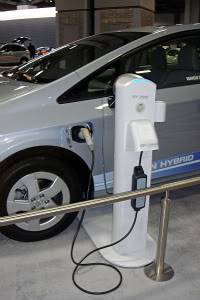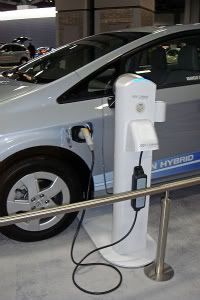Guest Blogger Lucas Jones Offers Suggestions for Electric Vehicle Design


Automotive structure will have to go to a much lighter composition. Currently Carbon fiber is near the top, but there is a lot more than that available. Nobody seems to be talking much about Boron for instance. Structures where the voids are filled with energy absorbing materials like EPP will significantly reduce weight while improving safety. Whole new methods will have to be devised to manufacture vehicles. Maybe methods
currently being used to produce Boats can be adapted. Certainly manufacturing in a specialized structure with highly trained staff will be necessary. Robots will have to be devised to increase speed and productivity.
There is no need to use an inefficient mechanical transmission in a modern vehicle. A simple copper wire is all that is needed. The wire goes from the battery to the motors via a controller and pushing on an accelerator or letting off is all that is needed.
Currently it seems that Lithium-Ion is the best power storage medium to use. When possible, charge them from the grid and recharge them with an internal gen-set when grid charging is not possible.
There exist a number of good gen-sets right now. My suggestion is for a simple and highly efficient design consisting of an air-cooled diesel, two-cycle, two cylinder opposed engine. The shaft is also the generators main shaft and the engine is run at its most efficient speed.
This is what we should be building right now. In my opinion Ford and GM will go bankrupt before they even begin to catch on. (Comment made in 2004.) During 2004 and 2005, I offered anyone who would listen the following information. None of the American automobile companies have even responded.
I have had some positive response from several educational institutions but – as far as I know – none have done any experimental work to verify my claims.
Here is what I have been proposing:
Fuel cells or Hydrogen will never become a significant power source for automotive power. Anyone who has taken a careful look at it knows this. If we could find someone in our auto industry with just a tiny bit of imagination, who knows what we could do? In one scale or another every one of these systems have been proven.
Want to produce a vehicle that can burn rubber on takeoff on all four wheels and get 90+ mpg?
What I would like to see the automakers working on would have:
A turbocharged, two cylinder opposed, 2-cycle, air-cooled diesel directly driving a generator. (It would not be running most of the time.) A 111 volt Lithium-Ion Polymer battery pack. Nothing but wires going from the controller to every wheel, except for the necessary additional friction brakes (of course). An added advantage of this would be the ability to recharge from the electrical grid while at home, saving even more on fuel.
Each wheel, depending on the feedback to the controller from wheel speed sensors would drive with just the right power depending on the accelerator position. You would get recharging from deceleration just as you do in today’s hybrids. You would also use this feedback to stop the wheel from skidding. Siemens VDO has developed a very interesting version. Several others are in process.
Each wheel would have a stationary stator and a series of fixed magnets closely adjacent all around the inside of the wheel. In a sense it would operate each wheel in a very similar fashion that the mag-lev trains use, except the motion would be circular.
Something very different about this type of motor is that the stators are fixed to the axles and the magnets are driven around them. This gives a significant increase in mechanical
advantage. That’s like turning an ordinary electric motor inside out.
There would be no need for ordinary electric motor brushes. In fact, many electric motors operating today are brushless.
Such motors already exist in the model airplane field and their efficiency is amazing – approaching 90%. I’ve got a couple and doubt that I would ever buy any other type.
It’s possible to hang the model on the prop right out in front of you and accelerate straight up, like a rocket, with this type motor. In the vehicle the motor/generator would not turn on to recharge the batteries until they needed it. There are already experimental Lithium-Ion driven cars that can get in excess of 200 miles before they have to be
recharged by plugging them in. You would top off you batteries overnight by plugging them in. Some cutting edge research by Toshiba – employing nano-technology – indicates that recharging can be done so fast that you could top off while eating lunch.
Lithium -Ion battery technology is improving every day. Their energy density exceeds that of any other form of rechargeable energy storage. It is the most efficient battery available right now. So is the outer rotor electric motor the most efficient motor.
Build an Automobile right and it will weigh less and have simpler, easier to repair/replace modules. Let’s see what we can eliminate while improving
performance and efficiency.
Transmission – None
Ignition system – None
Liquid cooling – None
Valves and valve train – None
Jones can be reached at: qazx@silverstar.com
